(Note: The quote cited in the headline is from Kirby Dick and Amy Ziering’s documentary On The Record (2020) and the words of the female main character Drew Dixon accusing a producer in the music industry of sexual abuse).
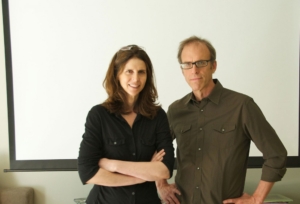

The directors Kirby Dick and Amy Ziering have a documented excellence in investigative documentaries, for instance The invisible War – however not all their documentaries have the same high standard.
“The private is political” was one of the slogans of the 1968-generation. With this they alluded to family structures, sexuality and norms as an important domain of public and political interest. As for instance Michael Renov has documented in his book The Subject of Documentary (2004), this slogan also left its mark on documentary. From the 1960s and on we see a wave of intimate, autobiographical documentaries and documentaries also dealing with the privacy of others and the life behind the windows of private homes. This can lead to greater knowledge of the human self, and the interaction between people in everyday life. It can develop explorations of how the public and private sphere influence each other and the understanding of self and others in private and public. A fantastic documentary demonstrating this is Sarah Polley’s documentary about her own family secrets in Stories we tell (2012). One can hardly call it an investigative journalistic film, but it works it’s way through layers of family life and memories, statements from people with very different perceptions of their family, to reveal a deep and very private secret. In this film it is her role in the family, her ability to talk to and reveal secrets in her own family, which gives it not just journalistic and documentary credit but also an ethical standard. The authoritativ, investigative documentary is just one of four basic prototypes. Other forms like observational documentary, dramatised documentarry and poetic reflexive documentaries also have ethical standards, but they often treat reality differently (see Bondebjerg 2014 and 2020).
However, even though the private sphere can be as important for documentary storytelling and investigation as documentaries about the public sphere, Jürgen Habermas’ theories of the public sphere (Habermas [1962] 1989 and 2006) has taught us that democracies also rely on the respect of privacy. Only under certain circumstances can the state or other public institutions intervene in the private sphere. A social anthropologist like Erving Goffman has also in his book The Presentation of Self in Everyday Life (1959) famously described the psychological, social and communicative differences between frontstage, backstage and deep backstage behaviour. When documentarists make investigative documentaries about cases in the public sphere, the private sphere or cases crossing that line, they must be aware of these different spheres and the roles we often play on the different stages. In many ways, documentaries entering deep back stage need to live up to even higher journalistic and ethical standards than those investigating cases of a public nature.
As humans we act and speak differently on the different stages we move on in everyday life. We tend to be more open when we go private and speak to people, we have a close daily relationship with. We also know that people on the front stage, for instance speaking to the media, presenting themselves in different kinds of public, have a tendency to conceal certain aspects of their life, or just try to present themselves in a strategically convenient way. If we do that in a court room it may be a criminal act, but most people mostly do not directly lie. It is just very human to try to present yourself and your case in the most favourable way. Again, this means that the tendency for people representing public institutions or private companies to speak with different voices when confronted with investigative journalism, may be even stronger when they are confronted on deep backstage matters.
The thin line between private in media saturated societies
In our more and more mediated society, the line between the public and private sphere has become thinner. Tabloids and popular weekly magazines have always thrived on peeping into the lives of public figures. By now, a series of reality TV formats and also documentaries get their stories also from ordinary people and their will to uncover deep backstage secrets on a public scene. Social media also tend to reveal and produce more journalism on very private matters. Combined with swift reactions to free floating accusations against groups or specific individuals, this can lead to violations of central democratic principles, for instance, that individuals are innocent until proven otherwise. If we are dealing with criminal acts this means in a court of law. However, as we shall see in the following, investigative documentaries can and have often made investigations that directly lead to legal action or retrial of old cases.
Social media and the more active interaction between private and public has its benefits. We can discuss difficult matters in the open, we can reveal and perhaps change structural problems. However, the flipside is also obvious, if private individuals are accused and condemned in public without respect for normal, legal procedures. The media have an important role as investigative voices and as the watchdog on social and political matters of public interest. However, when media condem and convict private individuals that are accused of potentially criminal offenses based on only voices of accusers and before legal action – ethical and democratic standards is at stake.
If the journalistic media and social media act as both investigators and judges – we have a problem. Sexual crimes and accusations of harassment have examples of both: on the one hand victims have a better opportunity of coming forward and society can become aware of systemic malfunctions that need to be changed; on the other hand, public opinion can be a very cruel and swift judge and leave individuals condemned and convicted, even though no legal procedure has taken place. It is therefore important in not just true crime documentaries, but in all other forms of authoritative, investigative documentaries, to follow the common journalistic procedures and ethical rules. This is particularly important when dealing with the private family sphere, with deep back stage, and with cases accusing private individuals in public. Often a more institutional, systemic approach to such cases is stronger than chasing individuals.
True crime documentaries: the dark side of humans and society
True crime is a prominent, relatively new term for a type of documentary which seems to have grown in popularity in the last ten years. Not just on transnational streaming platforms like Netflix and HBO, but also on national public service broadcasters like BBC, and other national broadcasters like for instance the Danish DR and TV2. Crime has on the other hand been popular for a long time on film and television, both in fiction and in documentary. Crime tends to be a theme which allows for the confrontation between not just law and order, but also deeper moral issues about human nature and the scary thin line between a shiny frontstage and a dark deep backstage. True crime documentaries tend to be authoritative, investigative and journalistic documentaries, but also come in other genre formats.
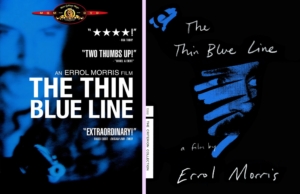
Even before the true crime genre became a popular label, Eroll Morris made one of the best and most creative films.
A prominent, early example of a very complex true crime documentary – long before the term was invented – is Erroll Morris’ The Thin Blue Line (1988). The criminal case deals with a completely ordinary man convicted for a murder, which the film proves beyond doubt was actually done by another person. Following the film, the innocent man was released, and the real murderer convicted. The film is indeed a really impressive piece of investigative journalism. Different forms of evidence, witnesses and potential explanations for the crime is seen from many angles. As viewers we do not just hear the different versions told by the different witnesses, it is also visualised as small narratives.
The film is about an individual case, but at the same time this case is used for a more general, system-oriented look at the American police and legal system and the way they operate. The film even goes deeper than that. The scene for the film is Texas, and a broader discussion of American culture and society, with many visual and symbolic layers, is characteristic for the film. Even though it deals with one individual case, it doesn’t deal with the private sphere, it deals with system problems, institutional problems and plays into the public sphere. It is a prime example of the classical crime investigation where all journalistic and ethical rules are followed, and at the same time it is aesthetically a very creative documentary.
This is certainly not always the case in true crime documentaries, where we often see a narrow focus on the crime in itself and less on the wider public interest behind individual cases. In such cases, some true crime documentaries may appeal more to a simple sensational, populist fascination with the dark side of humans and society. In itself this interest is legitimate; crime does expose and raise important social and psychological issues. However, authoritative-investigative documentaries in particular must live up to high journalistic and ethical standards. This is not always the case, especially if we are dealing with issues related to sexual allegations in the private sphere and with high-profile public figures. When true crime documentaries deal with sexual abuse and crime, we sometimes see a tendency to select juicy stories related to high profile characters.

Jarecki’s true crime series is a masterpiece of investigative journalism.
The question of fairness and impartiality in complex crime cases is important, and it is important to hear all sides and voices, both the claimed victim and the claimed perpetrator. In Andrew Jarecki’s HBO-documentary series, The Jinx: The life and Death of Robert Durst (2015), this principle is obeyed very carefully. It deals with the millionaire Robert Durst, suspected of several crimes, including the murder of his wife. Andrew Jarecki’s interest in Robert Durst, a New York real estate agent dates back to 2010, where Jarecki made a fiction film All Good Things about him, based on his autobiography.
Durst was rather pleased with the film and offered to give extensive interviews for the documentary, Jarecki was planning. Durst was suspected of killing his own wife, Kathie in 1982, but never accused. He was also suspected of killing a neighbour, but never accused. On the other hand, he confessed to having killed his friend, the writer Susan Berman, but he claimed it was in self-defence, and he was acquitted for this murder. This acquittal happened on the very day the last and sixth episode of the Jarecki’s documentary series was shown, a series that found hard evidence of Durst’s guilt in the two murders he was never accused of.
Jarecki’s documentary series is a very thorough and convincing peace of investigative journalism with both systemic and individual case dimensions. The systemic perspective has to do with a system failing to convict a multiple murderer. The individual case dimension is a very deep insight into a man with a front stage image as a successful business man, and a deep back stage image as a ruthless killer of people that got in his way. Apart from the journalistic evidence brought together in the six-part series on the murders and Durst’s life in general, Jarecki also interviewed Durst for more than 20 hours over several years. The interviews are in parts inserted into the documentary, and this also makes it a story of the mind of a criminal. In the last interview – unaware that the microphone was still on – he confessed to all three murders. The trial against the now jailed Durst, based in part on the new evidence put forward in the documentary, is scheduled for 2021. True crime can – if done well – have strong implications for both the system and individuals.
Sexual crimes: public and private dimensions
Kirby Dick and Amy Ziering’s 4 hour long documentary series on HBO, Allen vs. Farrow (2021) has divided critics and audiences all over the world. The intensity of the reactions clearly has a lot to do with the fact that the accusations of incest and the long bitter fight involve two high profile figures of American film culture, Mia Farrow and Woody Allen. It is also clearly fuelled by the rise of the #MeToo movement. The many cases of sexual harassment in several sectors of society and the criminal cases against “powerful” men in the American film culture, Harvey Weinstein and Bill Cosby for instance, seem to have been one of the reasons for the two directors to take up a case that is almost 30 years old and has already been treated widely in a number of media.
Whereas other Hollywood-figures have been taken to court and are convicted for their crimes, Allen has never been on trial and convicted for Farrow’s accusation of incest against the 7-year-old step daughter Dylan. On the contrary, the case has been dismissed by two public investigations. The New Haven Child Abuse Center was asked by the Conneticut prosecutor to investigate the case an concluded after six months that there was no evidence of abuse. The ruling was among other things based on the videos taken by Mia Farrow with Dylan about the alledged crime and medical examinations and other forms of investigatio. So the videos of Dylan as 7-year old is NOT new evidence, even though they have never been released publicly before. The second investigation was lead by the New York prosecutor Frank Marco. He stated publicly that he had reason to beleive there could be a case against Allen, but he did not open a case. His reaslons for that was to protect Dylan from a traumatizing court experience (see on this also Monggaard 2018 and Yde and Monggaard 2021).
On the surface the film tries to present an investigation based on critical readings and re-evaluations of very old case documents and other forms of material. The only totally new thing is the grown-up Dylan’s statement on camera. However, judged as a four-hour long documentary on a case that goes deep into a long running family feud, a main problem is that it so obviously stages the whole case from a Farrow family point of view. It would have been a very different and more solid journalistic and ethical series, if we had been directly confronted with statements from both the Farrow family and the Allen family. The Danish journalist Mette Davidsen-Nielsen recently wrote:
“No matter what you think of Allen vs. Farrow, we can conclude that it has not contributed to a clarification creating any form of consensus. On the contrary, the series plays into the #MeToo polarisation and very stable and divisive positions. Here you can be convicted and acquitted in advance.” (Davidsen-Nielsen 2021).
Kirby Dick and Amy Ziering seem to have specialized in sexual true crime documentaries, and Allen vs. Farrow is their fourth documentary on such issues, but the first series. These four documentaries can all be defined as examples of the authoritative, investigative documentary genre, a format most often used in true crime documentaries. They claim to have used almost four years on research on Allen vs. Farrow (Adams 2021), and their previous documentaries have also given them credit for excellence in this particular genre. It is a demanding genre which most live up to the highest journalistic and ethical standards.
The fact that such documentaries accuse systems and institutions and also individuals of potentially serious crime, demands un-biased fact-based research, documentation of all evidence in the case and giving those accused a fair chance of presenting their case. Most often documentaries of this kind need and normally use legal advice to avoid pitfalls. To a certain degree such documentaries have to follow some of the same rules as police and courts. Attacking systems or individuals suspected of crime will of course sometimes run into the problem that they resist commenting and give statements – this only complicates things further.
Dick and Ziering’s first documentary on sexual harassment The Invisible War (2012) deals with the deeply problematic sexual culture in the US-army. It has won several international prizes and a Peabody Award and Emmy Award as both Best documentary and for Outstanding Investigative journalism. It is almost an ideal example of a classic, investigative journalistic documentary, and it managed to create very fundamental changes in military institutions and norms. It is an example of what a documentary focusing on institutional structures and using strong cases and statements by victims and those responsible for the military institution can accomplish. Here all sides are heard and included.
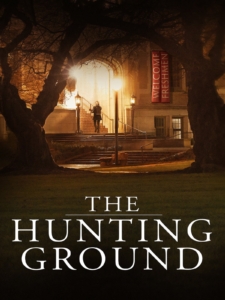
We find the same kind of approach in The Hunting Ground (2015) putting sexual harassment in US universities on the agenda. Although the film received serious criticism from 15 prominent legal professor for tampering with data and for exposing especially one famous baseball player among the cases, the film still met wide approval and led to changes. The focus on this theme continues in Dick and Ziering’s next film on sexual abuse, On the Record (2020), this time focusing on the music industry. However, there is a change in focus and documentary approach, since we follow especially one woman, who claims to have been raped by a very powerful man in the music industry, but who is having second thoughts about whether to go public with her accusation. We still have an institutional context, but the central case is between a female victim and a powerful man. #MeToo has made its mark on this documentary. Despite this legal-ethical problem of accusing an individual in a film and not by filing a legal case from the beginning, the film raises an important criticism of sexual misconduct of potential crimes in the music industry.
When an investigative documentary fails to meet the standards
As already indicated Dick and Ziering’s latest series claims to have the same valid quality as their former documentaries dealing with the #MeToo agenda, and we find lots of evidence in the series of their long period of investigation. So the film is no doubt based on a very thorough investigation of this extremely complicated case. The investigation is also clearly influenced by the problem that some of the original witnesses are dead. However, despite the thorough investigation and the intention to live up to journalistic and ethical standards in such documentaries, one starts to wonder, when they claim that Allen vs. Farrow allowed them to expose a “much broader, richer and deeper palette” than their former documentaries (Adams 2021). This question about the motives behind the documentary becomes even bigger, when the two directors go on insisting, it was Dylan’s and the Farrow family’s side of the story which needed to be explored, because: “this story had not only not been thoroughly investigated, but the spin that Woody Allen put out has really created a situation, where this country has the wrong perspective on this story.”
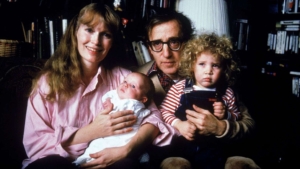
No matter how you view the case, it seems rather difficult to see it as richer, broader and deeper than their previous films. Allen vs. Farrow has a rather narrow focus on one incident in 1992, it involves a limited number of people in the extended Farrow-Allen family. The case has been covered widely since 1992 in all sorts of media and in different forms of public investigations. Although Allen was never convicted, he has in many ways been hit hard by the public opinion, to such a degree that he has been forced to make many of his films since 1992 in Europe. So the statement of Allen as a powerful film maker able to spin and control the media falls flat.
Although the series seems to put Allen in line with convicted sexual criminals, there are no other cases to be found on him besides this case in 1992, so Allen is by all standards innocent. The basic rule is, that we are all innocent untill proven otherwise. Even worse is the attempt to find evidence in Allen’s films of incestuous themes. There are no such themes to be found in his films. To compare an accusation of incest with a child with fictional films about relations between older men and younger females is really far-fetched. It seems to indicate that they have gone far to find new evidence, no matter the quality. So is the allusion to Allens relationship and marriage with Farrows adopted daughter Soon-Yi. She was 19 when they first met, the exact age as Farrows, when she married the much older Frank Sinatra.
When an otherwise well researched documentary starts to include such a hypothetical and complete unfounded arguments in what is a potential criminal case against Allen, the scepticism towards the whole construction of the film becomes very relevant. The very foundation and reason for making the film and the narrow and biased perspective starts to look completely flawed. It would have been a real challenge if the filmmakers had pursued a kind confrontation and investigation of both sides of the story, giving a voice to both Allen and the family supporting him, a voice with the same importance as the extensive Farrow family. To choose only to give voice to the Farrow side with new present day testimonies on top of the many past statements from 1992 and on, is simply a violation of the basic rules and ethics of investigative journalism.
The statements in the film from Allen are all selected by Dick and Zieming, which means that “the accused” is not given a proper voice in the film. There are also very few witnesses speaking for Allen, while those supporting Farrow are abundent. Any individual is innocent until the opposite is proven, and the proof cannot be based on only one side of the story. Having watched all four hours of the series, on starts questioning if this is the most important story to tell. It seems to be a very long and neverending family feud. What is the public interest?
Nobody watching the four-hour long documentary can probably avoid being emotionally touched by the release of the video Mia Farrow filmed over many days just after the claimed accident took place with the 7-year-old Dylan. The same goes for the interview made with the grown-up Dylan by the two film makers. But as an ordinary viewer without special expertise in incest one needs to remember, that the 1992 video was used in the investigation in 1992, and that we cannot know the context of the statement of the now adult Dylan. It is completely relevant and acceptable that the film confronts us with Dylan’s statements. But it is only one side of the story, and we need the full story, including the voices of at least Allen, Moses Farrow and Soon-Yi, who seem to agree with Allen’s own rejection of the accusations. Moses and Soon-Yi are known to have very hartsh and critical views of Mia Farrow as a mother. Such voices and many others are completely absent from the series.
Such family conflicts over many years, the fact that incest cases are notoriously extremely difficult to handle, should make viewers be very cautious in following a series so insistently being partisan and obviously biased. Perhaps it is also wise to remember that Ronan Farrow, Allen’s biological son with Farrow, has taken his mother’s side in public. He has done that so forcefully, that he also successfully tried to prevent his own publisher in publishing Woody Allen’s autobiography, which was then published elsewhere, Apropos of Nothing (2020). Ronan Farrow won journalistic claim for his book Catch and Kill (2019) about sexual ‘predators’ and abusers. But his journalistic ethics seem to have failed him in the Allen-farrow case (see also Worley (2020). If you want to protect our democracy and the freedom of speech for yourself it is not wise to try a prevent your opponent/enemy from the same right.
The documentary series by Kirby Dick and Amy Ziering have perhaps not gone that far, but they have certainly violated basic journalistic and ethical rules. The series is not just too biased. The aesthetic space around the Farrow family is made in a softer, milder visual style than the few old clips with Allen, and the fact that all quotes or visuals with Allen are selected and edited by the filmmakers further raise doubt of truth and representation. I am no legal expert, but it also seems to me that the extensive use of Frank Maco, the prosecuter who was in charge of the third investigation, almost appears as a friend of the family in the film. I am also puzzled by the original decision of Frank Maco shown in the film, where he states that he had good grounds to believe in Allen’s guilt, but would not open a case in order to protect Dylan from witnessing in the court. As if systems do not have means to treat such cases, where minors are involved. How can a prosecuter publicly accuse a person and then not take the case to court?
It seems to me at least, that this is in a way what the wole film does. Without final proof, without giving the accused a real voice in the film, without listening to counter-witnesses, by using a tainted film style, the film in reality find the accused guilty. The film has not really given us new and valuable information, and the long and detailed attempt to undermine all previous investigation into the matter is flawed. I fail to understand why such skilled investigative documentarists as Kirby Dick and Amy Ziering use so much time on and old case and on what seems to be a deep backstage story of a family feud of little interest to the public. I fail to understand how HBO can broadcast a documentary series like that. The #MeeToo agenda is too important to be side-tracked by what seems to be a very personal and private vendetta. Allen is thus to me innocent, until proven otherwise.
References
Adams, Sam (2021). Allen vs. Farrow’s directors on how making the series changed yheir minds about what really happened. Slate Magazine, March 14.
Bondebjerg, Ib (2014). Engaging With Reality. Documentary and Globalisation. Intellect/Chicago University Press.
Bondebjerg, Ib (2020). Documentary, Culture and the Mind. Saxo publish/Saxo.com.
Davidsen-Nielsen (2021). Woody Allen var både dømt og frikendt på forhånd. Politiken, March 20.
Goffman, Erving ([1959] 1990). The Presentation of Self in Everyday Life. Penguin Books
Habermas, Jürgen ([1962] 1989). The Structural Transformation of the Public Sphere. Polity Press.
Habermas, Jürgen (2006). Political Communication in Media Society. In Communication Theory, 2006:16, p. 411-26.
Monggarad, Christian (2018). Er Woody Allen skyldig eller ikke skyldig – døm selv. Information 26. januar.
Monggaard, Christian og Katrine Horsnstrup Yde (2021). En ubehagelig samtale om Woody allens skyld …”Nej Uskyld!” “Nej Skyld!”. Information 20. februar.
Worley, Rick (2020). The Rise and Fail of Ronan Farrow. https://ronanfarrowletter.wordpress.com/2020/07/20/the-rise-and-fail-of-ronan-farrow/

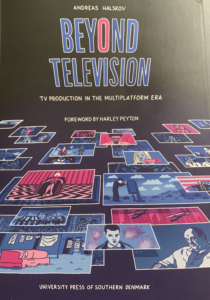
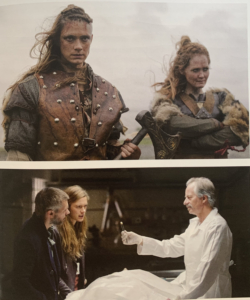



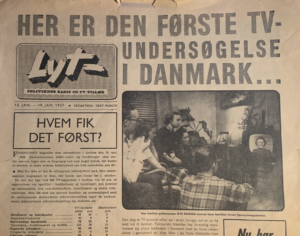

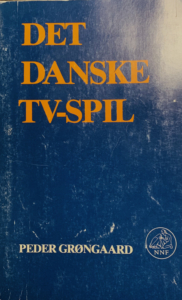






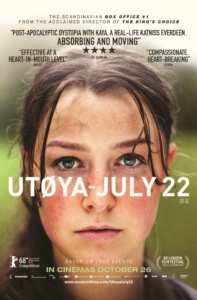






 I seriens afsluttende afsnit bevæger vi os derfor også fra den juridiske retfærdigheds sejr, – baseret på et team af efterforskere, som endelig får ros med mere end fem ord og et klap på skulderen af Jens Møller – til menneskelighedens sejr. Den kriminalistiske tragedie svøbt i tunge græske gevandter vender til en mere mild og rund hyldest til dem der skal føre livet videre: Jens Møller kan omsider kejtet og rørt tage sit første barnebarn i armene, og annoncere at han går på pension; Ingrid Wall kan forelæse for en gruppe af journaliststuderende, mest kvinder, om at bære Kim Wall’s fakkel videre; Joachim Wall dykker videre for at redde sin datters journalist-filer. Det er i det hele taget lyset og den fornyede energi der sætter ind efter mørkets nederlag.
I seriens afsluttende afsnit bevæger vi os derfor også fra den juridiske retfærdigheds sejr, – baseret på et team af efterforskere, som endelig får ros med mere end fem ord og et klap på skulderen af Jens Møller – til menneskelighedens sejr. Den kriminalistiske tragedie svøbt i tunge græske gevandter vender til en mere mild og rund hyldest til dem der skal føre livet videre: Jens Møller kan omsider kejtet og rørt tage sit første barnebarn i armene, og annoncere at han går på pension; Ingrid Wall kan forelæse for en gruppe af journaliststuderende, mest kvinder, om at bære Kim Wall’s fakkel videre; Joachim Wall dykker videre for at redde sin datters journalist-filer. Det er i det hele taget lyset og den fornyede energi der sætter ind efter mørkets nederlag.








